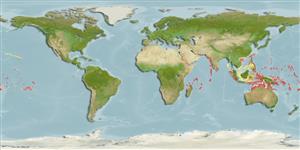>
Anguilliformes (Eels and morays) >
Ophichthidae (Snake eels) > Ophichthinae
Etymology: Phyllophichthus: Greek, phyhllon = leaf + Greek, ophis =serpent + Greek, ichthys = fish (Ref. 45335).
Environment: milieu / climate zone / depth range / distribution range
ນິເວດວິທະຍາ
ສັດທະເລ ກ່ຽວກັນຫີນ; ລະດັບຄວາມເລິກ 8 - 30 m (Ref. 30874). Tropical; 28°N - 18°S
Indo-Pacific: East Africa to Hawaii and the Society Islands; north to Ryukyu Islands; south to Australia; East Indies, from Christmas Island and Indonesia (Flores and Molucca Is.).
ຂະໜາດ / ນ້ຳໜັກ / Age
Maturity: Lm ? range ? - ? cm
Max length : 42.0 cm TL ຕົວຜູ້/ບໍ່ມີເພດ; (Ref. 1602)
Short description
ຕົວທີ່ໃຊ້ໃນການຈຳແນກຊະນິດ | ສະລີລະວິທະຍາ | ການວັດແທກຮູບຮ່າງລັກສະນະພາຍນອກຂອງດິນ,ສັດ,ປາ…
ສັດທີ່ມີກະດູກສັນຫຼັງ: 157 - 179.
A benthic (Ref. 58302) and burrowing species which occurs in inshore waters (Ref. 7300, 75154).
Life cycle and mating behavior
ການຈະເລີນເຕັມໄວ | ການສືບພັນ | ການວາງໄຂ່ | ໄຂ່ | ຄວາມດົກຂອງໄຂ່ປາ | ຕົວອ່ອນ
Myers, R.F., 1991. Micronesian reef fishes. Second Ed. Coral Graphics, Barrigada, Guam. 298 p. (Ref. 1602)
IUCN Red List Status (Ref. 130435: Version 2024-2)
Threat to humans
Harmless
Human uses
ເຄື່ອງມື
Special reports
Download XML
ແຫຼ່ງອີນເຕີເນັດ
Estimates based on models
Preferred temperature (Ref.
123201): 26.4 - 28.8, mean 27.9 °C (based on 194 cells).
Phylogenetic diversity index (Ref.
82804): PD
50 = 1.0000 [Uniqueness, from 0.5 = low to 2.0 = high].
Bayesian length-weight: a=0.00091 (0.00039 - 0.00215), b=2.99 (2.79 - 3.19), in cm total length, based on LWR estimates for this (Sub)family-body shape (Ref.
93245).
ຊັ້ນເຂດຮ້ອນ (Ref.
69278): 3.7 ±0.6 se; based on size and trophs of closest relatives
ຄວາມຢືດຢຸ່ນ (Ref.
120179): ສູງ, ປະຊາກອນຕຳ່ສຸດທີ່ໃຊ້ເວລາສອງໜ້ອຍກວ່າ 15 ເດືອນ (Preliminary K or Fecundity.).
Fishing Vulnerability (Ref.
59153): Low to moderate vulnerability (32 of 100).
Nutrients (Ref.
124155): Calcium = 57.7 [32.8, 106.3] mg/100g; Iron = 0.602 [0.368, 1.172] mg/100g; Protein = 18.7 [16.5, 21.3] %; Omega3 = 0.115 [0.053, 0.328] g/100g; Selenium = 36.3 [20.5, 74.0] μg/100g; VitaminA = 63.8 [18.5, 191.3] μg/100g; Zinc = 1.13 [0.80, 1.57] mg/100g (wet weight);
